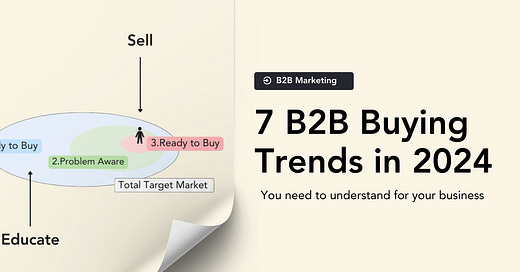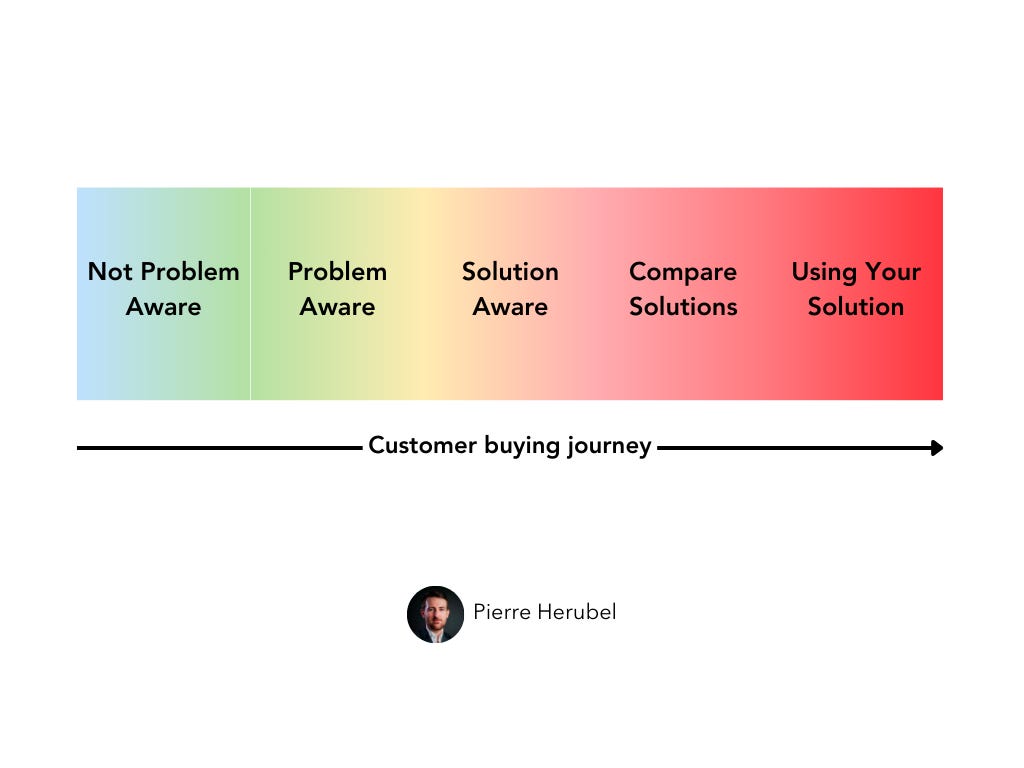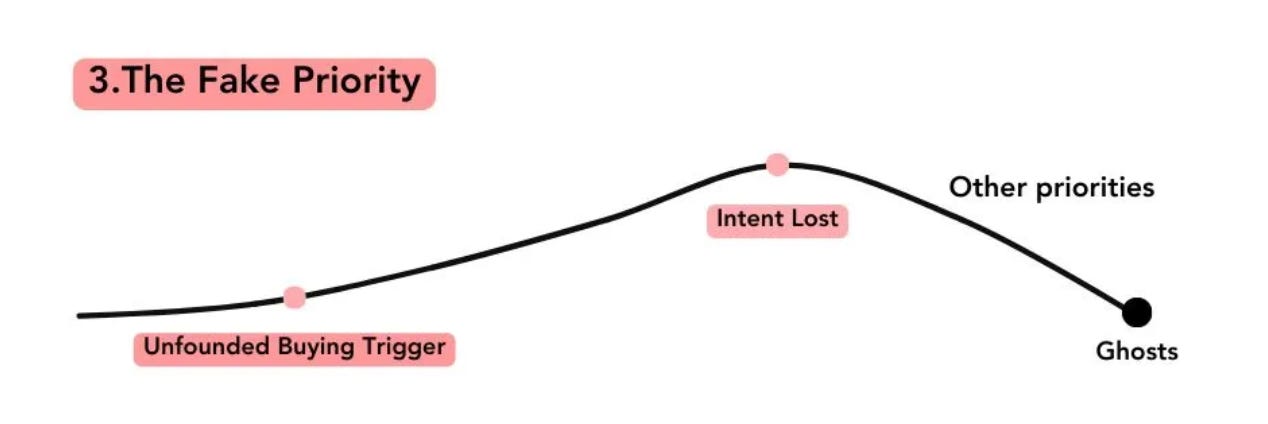👋 Hello
Welcome to this edition about:
The 7 Concepts to Understand Your Customers [Guide]
You’ll learn the 7 B2B buying trends as follow:
Active vs passive buyers
The stages buyers go through
Non-linear buying journey
Buying committees
Buying dynamics
Buying intent
Buying is a project
👋 Before jumping into the edition - here is a 11min masterclass:
The authority-first framework that allowed me to get 88K followers interested in marketing:
Introduction
If you don’t take into consideration the buying trends and mechanisms, you’ll end up like an annoying noise in the market. Indeed, pushing aggressive sales techniques to every prospect is not a good solution.
Instead, you should aim to always understand your target market and especially how they make decision. Here is a graph that explains this concept:
Here are some examples of actions you should conduct:
Assess your total market
Gather intent to identify active accounts
Publish content for passive and unknown accounts
Deploy ABM and social selling for accounts with intent
Now let’s have a look at the 7 B2B Buying Trends to Understand
1. Some Buyers are Passive, they are not all actively buying now
🌰 In a nutshell - Some people are ready to buy, but most of the market is not ready to buy. Take this fact into consideration.
You have to prepare and act for 3 types of prospects:
Ready to buy → aim to convert them into clients
Problem aware → aim to make them “ready to buy”
Not ready to buy → aim to turn them into active buyers
That’s why you should always have marketing tactics for:
Short term revenue
Medium term revenue
Long term revenue
Otherwise, you might end up in a terrible situation:
You are always in a hurry to close deals
So you push promotions and “needy” marketing
You start using aggressive sales techniques
And eventually you become a distant annoying noise in the market.
2. Buyers are going through a series of Buying Stages
🌰 In a nutshell - Buyers rarely decide to purchase solutions out of the blue. They first go through a complex process.
When a prospect decides to buy, it’s become he has been through a series of stages. They don’t (or rarely) wake up and decide to buy a product, and close the deal the same day. They go through important steps that include:
Researching about the problem and potential solutions
Making a list of solutions and costs associated
Prioritizing based on objectives and features
Creating a buying checklist internally
Building a buying committee
Selecting a champion
Here is a theoretical way to describe the customer buying journey stages:
3. Buying Journeys are non-Linear
🌰 In a nutshell - The way B2B executives buy is influenced by many factors and touch points.
While you can have a macro view of buying stages (point 2), the behaviors within those stages and the speed of evolution are impossible to predict or control. That’s because buyers have non-linear journeys.
They take the time they want
They go faster when they want
They ask questions want they want
They take a step back when they want
They consume the information they want
For a marketer, it’s hard. Because your job is to analyze patterns and create a strategy based on those patterns. But it’s a market reality and reality is more important than theories or dream practices.
4. Businesses purchase with Buying Committees
🌰 In a nutshell - Because purchases are complex, multiple people and functions are part of the decision process.
In my career, I’ve met a lot of sales who were surprised that their champion had to double check everything with everyone internally. Legal team, tech team, finance team, approval team, purchasing department, legal team again, board… While this might be annoying on the seller side, it’s a very common process on the buyer side.
It’s because customers buy in committees:
The question is - is the buying committee well organized?
Some organizations have a chaotic buying process relying on opportunities and emotions.
Some organizations have a solid buying process relying on risk management and rational decisions.
Generally speaking, the more a company grows, the more the buying process gets structured and rational. So you should always expect longer sales process with bigger companies.
Some organization have to do a benchmark to compare 3 solutions providers. Even if it’s a $1500 per year SAAS. Every organization has its own rules when it comes to buying. It’s a mix of culture and their ability to take risk.
5. There are 2 types of Buying Dynamics
🌰 In a nutshell - Every company has a specific way to take decisions, but some patterns exist when it comes to buying.
Most startups are targeting CEOs because they feel it’s the group of people who make decisions. But most CEOs are extremely busy. And they often rely on their team (C-levels, VPs, or even managers) to come up with ideas, plans, new tools, or even new providers.
While your solution and messaging should be easy to understand for CEO, it should also convince the experts in charge. Here is an introduction to 2 buying dynamics:
Bottom up
Top bottom
Bottom up:
The need to find a solution is spotted from the operational team. They are actively looking for a solution to cope with a current limitation.
They know exactly what they need, and they ask for approbation to their management. Depending on the strategic level and the budget involved, they will be able to purchase by themselves directly.
For higher contract value, they will have to involve their management in the decision loop.
In this case, the managers will ask them to propose different alternatives with pros and cons.
Then the operational team and the managers will decide together on the best option (often involving a support function such as procurement or legal)
Top bottom:
The C-Levels or VPs (depending on the size of the structure) identify a market trend, a new opportunity, an ‘exciting’ project or an internal problem.
These new ideas often come from discussions with peers, analyzing competitors, reading news on social media, or getting influenced by thought leaders
They often do a quick surface-level research and ask the team to find a solution to implement. (e.g. a CEO will say “we really need to use AI to automate our sales workflow” to a VP of Sales)
The team lead will then be in charge of identifying solutions. He will often ask a benchmark, ideas, list of options from his team and consolidate a file.
Then he will show the options to the C-level and close the loop.
6. Buying Intent is an important factor in the buying decision journey
🌰 In a nutshell - The most powerful buying driver is intent. When someone truly wants to buy, everything is easier.
There are many factors that can influence buying intent. And they take time to appear and have a true impact. But sometimes, there are strong triggers that build intent really fast. Here are some examples:
You can also differentiate 3 types of buying intent as follow:
1. The Rational Intent → "We need to plan this"
Prospects understand they have a problem through self education or conversations. Their intent grow slowly but surely and they end up comparing solutions from multiple providers.
- Prospect has a solid buying checklist
- There is a champion leading the purchase
- Take time, but ask questions and follow up
2. The Urgent Need → "We need it NOW"
A topic is not important and the very next day it becomes the highest priority. Their intent comes from an external source such as a new regulation, a competitor move, or an external influence.
- "We need to start yesterday haha"
- Disorganized but plausible buying checklist
- Answer questions fast, decision makers included
3. The Fake Priority → "It's not a priority anymore"
The intent to buy suddenly appears out of nowhere (similar to scenario 2). The difference is that the buying trigger is unfounded. It is merely an "excitation burst" that vanishes after a few weeks.
- "What is the ROI, can you prove it?"
- Unclear need, no buying checklist
- It comes from founders fantasies
7. Buying something is a project, and projects can fail
When a sales or marketers can’t close a deal, they think:
“I did something wrong”
“The messaging wasn’t good”
“Was I too pushy? or not enough?”
Sometimes it’s because of the reasons stated above. But sometimes it’s because of something else: buying something is a project, and projects can fail. And there are multiple reasons why a project can fail.
Another priority becomes more urgent
The champion leaves the organization
Internal budgets are changed
Another big reason is the risk aversion:
You need to take into consideration these 7 buying trends in order to build a solid marketing strategy. Otherwise, you won’t be able to adapt your strategy to the market reality.
Alright, that’s the end of this edition about the B2B buying trends.
This gives you a good overview on how to adapt in the current B2B context.
👋 Did you know?
I packed 5 years of content marketing expertise into 1 online course. The waitlist is open!
I’m launching a course about my B2B Content Marketing system that helped me to:
Bootstrap a 7-figure agency
Get 100K followers online
Get $49K/month pipeline
📎 Click here to get more information and join the waitlist
(People on the waitlist will get exclusive advantages when the course launches)




















Simply the best!